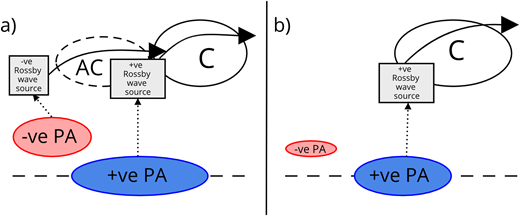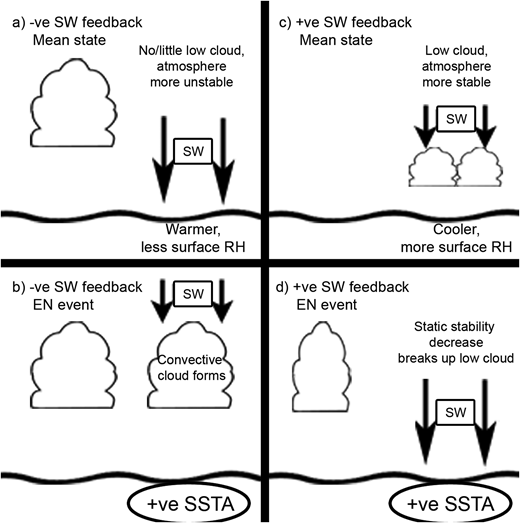Menu
Past Research
Tropical waves and High Impact Weather over South East Asia

|
Figure 6 of Ferrett et al. (2019): Likelihood of extreme precipitation (exceeding 95th percentile of precipitation for 1998–2016) during days with high‐amplitude wave activity at 850 hPa. Cases shown are (a) Kelvin wave at 100–105°E in DJF, (b) Kelvin wave at 110–115°E in DJF, (c) Kelvin wave at 120–125°E in DJF, (d) R1 wave at 100–105°E in DJF, (e) positive phase WMRG wave at 100–105°E in DJF, and (f) negative phase WMRG wave at 100–105°E during JJA. White shading (~5%) indicates no difference from the climatology. Line contours show the composite 850 hPa convergence or vorticity of the relevant wave field with intervals of 5 and 1 × 10−7 s−1 respectively. Solid purple lines indicate convergence/positive vorticity at 850 hPa, dashed purple lines indicate divergence/negative vorticity at 850 hPa |
Equatorially trapped waves, such as Kelvin Waves, Equatorial Rossby Waves and Westward‐moving Mixed Rossby–Gravity (WMRG) Waves, play a major role in organising tropical convection on synoptic to sub‐seasonal time‐scales. These waves have the potential to provide an important source of predictability for high‐impact weather in Southeast (SE) Asia and the Tropics more widely. This work found that increases in the amount of precipitation and the likelihood of extreme precipitation in SE Asia are linked to all three of these waves ; Kelvin, equatorial Rossby and WMRG waves. In particular, heavy precipitation can be up to three times more likely in regions of SE Asia during equatorial waves, including Malaysia, Indonesia and the Philippines. Therefore, the skill in probabilistic prediction of extreme precipitation in SE Asia would be expected to be conditional on the skill in equatorial wave prediction, and the modelled relationship between equatorial waves and convection.
El Niño-Southern Oscillation (ENSO) in coupled climate models
The El Niño Southern Oscillation (ENSO) is governed by a combination of amplifying and damping ocean–atmosphere feedbacks in the equatorial Pacific.
The role of the mean state in Northern Hemisphere ENSO teleconnections in coupled climate models
| Rainfall in East Asia is linked to ENSO via the formation and decay of anomalous anticyclones over the western North Pacific (WNP) during the ENSO warm phase, El Niño. An anticyclone in the lower troposphere begins to form over the Philippine Sea in the late fall and persists into the subsequent summer, suppressing the northerly winds along the coast of East Asia and weakening the East Asia winter monsoon . The Philippine Sea anticyclone is most strongly associated with subtropical rainfall changes in East Asia, and cannot readily explain the ENSO–Asia teleconnections farther north. East Asia rainfall during El Niño has been suggested to be a result of an anomalous anticyclone that forms farther north around 35°N in early winter and decays in late winter, termed the Kuroshio anticyclone. The formation and decay of the Kuroshio anticyclone is suggested to be a result of competing effects of positive precipitation anomalies over the equatorial central Pacific (CP) that are associated with an anomalous cyclone in the North Pacific, and negative precipitation anomalies in the tropical WNP that contribute to the development of the Kuroshio anticyclone . However, the relative strengths of the forcing precipitation responses are well captured in only a few of the current coupled climate models. In this work I examined the relationship between tropical mean state biases and these teleconnections in coupled climate models in order to gain greater insight into model bias. Results showed that biases in mean atmospheric circulation in equatorial Pacific are linked to differences in precipitation responses during El Nino that result in errors in teleconnection patterns in the Northern Hemisphere. |

Fig. 10 of Ferrett et al. 2020: Simplified schematic showing North Pacific Rossby wave source and cyclone (C) and anticyclone (AC) responses associated with precipitation anomalies (PA) in two cases: (a) a relatively strong western North Pacific negative precipitation anomaly and (b) a relatively weak western North Pacific negative anomaly. Dotted lines indicate the resulting source from a precipitation anomaly |
The role of the mean state in ENSO atmospheric damping in coupled climate models
|
The rate of damping of tropical Pacific sea surface temperature anomalies (SSTAs) associated with El Niño events by surface heat fluxes has significant biases in current coupled climate models. As part of a Postdoctoral position under the CSSP: China project in collaboration with the Met Office I examined the role of the equatorial Pacific mean state in ENSO damping biases in current coupled climate models. Sources of bias in both shortwave heat flux damping and evaporative damping were assessed. Results showed that biases in atmospheric conditions along the equator are linked to ENSO damping strength via differences in surface winds for latent heat damping and differences in cloud cover for shortwave damping, highlighting areas for improvement in future model development. |
 Fig. 11 of Ferrett et al. (2018): Idealized schematics of the equatorial Pacific showing (a) mean state conditions for models with negative shortwave feedback, (b) El Niño conditions for models with negative shortwave feedback, (c) mean state conditions for models with positive shortwave feedback, and (d) El Niño conditions for models with positive shortwave feedback.
Fig. 11 of Ferrett et al. (2018): Idealized schematics of the equatorial Pacific showing (a) mean state conditions for models with negative shortwave feedback, (b) El Niño conditions for models with negative shortwave feedback, (c) mean state conditions for models with positive shortwave feedback, and (d) El Niño conditions for models with positive shortwave feedback. |
PhD: El Niño-Southern Oscillation stability in a perturbed physics ensemble
My PhD work was based at the University of Exeter and focused on ENSO feedback assessment using the Bjerknes stability index, a metric incorporating a number of ocean-atmosphere feedbacks. This work was carried out using a flux-adjusted HadCM3 perturbed physics ensemble under present day conditions and a future emissions scenario. Relationships between feedbacks and both the present day biases and responses under climate change of the mean equatorial Pacific climate were investigated. Despite minimised mean sea surface temperature biases through flux adjustment, the important dominant ENSO feedbacks still showed biases with respect to observed feedbacks and inter-ensemble diversity. A drier west Pacific was linked to weakened shortwave and latent heat flux damping, suggesting a relationship between ENSO characteristics and biases in the hydrological cycle.